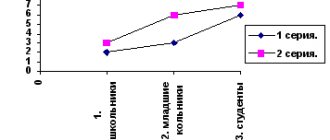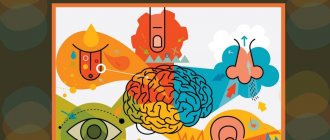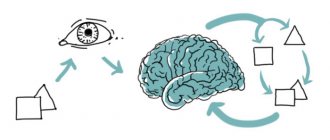Classification of perception by types of analyzers
According to the types of main analyzers, the following main types of perception are distinguished:
- kinesthetic,
- visual,
- tactile,
- olfactory,
- auditory,
- taste.
The process of perception is realized through analyzers that closely interact with each other. For example, tactile perception, which involves kinesthetic and tactile analyzers. In the process of visual perception, in which the visual analyzer plays a leading role, the participation of the motor one is required to carry out eye movements. In auditory perception, the auditory analyzer is the main one, but the kinesthetic analyzer is of great importance. Different types of perception are rarely present in their pure form; more often they are combined with each other.
Help with student work on the topic Classification of perception
Coursework 480 ₽ Essay 230 ₽ Test paper 230 ₽
Receive completed work or advice from a specialist on your educational project Find out the cost
Modality in psychology
The human representational system is represented by perception channels or sensory receptors. Modality in psychology is a qualitative spectrum of sensations and internal processing of received information through the use of certain senses. In neurolinguistic programming (NLP), determining a person’s leading modality is an important step for successfully presenting information to the client.
Modalities of perception
There are the following modalities of perception in psychology:
- rational modality (mental operations);
- kinesthetic (touching, movements in space, tactile sensations);
- auditory (auditory);
- visual (visual).
Modality of sensations
All living things in nature have sensitivity. The modality of sensations in psychology is receiving information from the outside world through sensory analyzers:
- vision (color and brightness);
- hearing (sound wave vibrations);
- touch (pressure, heat-cold, temperature, pain);
- sense of smell (smell);
- taste (food quality).
Each personality is unique, but there are common components that allow an individual to be classified into a particular group or descriptive characteristic. Psychologists, having conducted a series of studies, discovered that every person has a leading sensory system, which made it possible to create a classification:
- Auditory
– incoming information is better analyzed by auditory analyzers. Such a person often uses the expressions “I heard that...”, “sounds tempting/impressive”, “hurts the ears”, “I don’t even want to listen to this!”. - Visual
– thinks in images. The visual type uses words associated with visual actions, colors: “bright/rich/colorful/dull”, “it seems to me”, “notice/focused”. - Kinesthetic
- bodily sensations and touch are very important for the kinesthetic type. The gestures and facial expressions of such people are very rich. In the expressions you can hear the words: “pleasant”, “warmth”, “goosebumps”, “I am unbearably disgusted”.
Modality of thinking
The principle of modality of thinking is the ability to think in various parameters. For humans, the modalities of perception and thinking are equally significant and constantly involved. Classification of modalities of thinking by Ya. Startsev by type:
- Rational modality
– involves the categories “true - false”. The concept of truth is used as a filter in the selection, structuring and transformation of information. - Aesthetic modality
- artistic images. The formation of images occurs in mental reality, then is reflected in the physical world through works of art and literature. - Instrumental modality
– manipulation of an object in the physical world and mentally. Work-related skills, consolidation of useful experience and separation of useless ones. - Magical modality
is irrational thinking, focused on symbols, signs, miracles. Coincidences at the same time confirm the correctness of a person’s judgments, due to clarity. - Ethical modality
– behavior, intentions and attitudes of people. Subject-subject interaction. Any action or intention is assessed from the standpoint of norms accepted by society. Ethical thinking “thinks” in categories: “good-evil”, “good-bad”.
Modality of emotions
Emotions are usually divided into positive, negative and dual (ambivalent). Emotional modality is the subject’s experience of a particular emotion. K. Izard (American psychologist) developed a theory of basic differential emotions or modalities:
- joy – a positive attitude towards the world and oneself;
- interest – the ability to perceive and assimilate information;
- surprise – sudden changes;
- sadness is an experience associated with the loss of an object to satisfy needs;
- disgust is the emotion of rejection;
- anger – readiness to attack in response to causing discomfort;
- contempt - a feeling of superiority, devaluation of another person;
- shame is a person’s experience of inferiority;
- fear - an emotion associated with situations of threat, readiness to escape;
- guilt - self-flagellation and condemnation as a result of an offense.
Memory modality
A person’s leading modality does not mean that he does not use other sensory channels. All systems are involved to varying degrees. Based on the main modalities of perception, there are types of memory:
- Visual
– memorizing incoming visual images. - Auditory
- incoming sounds, noises, music are remembered. - Gustatory
– a person remembers different tastes. - Tactile
– memory of images, preservation and reproduction of actions/movements; - Motor
– formation and memorization of motor skills. - Olfactory
– memory for smells. - Emotional
– all experienced feelings and emotions are remembered.
Channels of perception: visual, auditory, kinesthetic, digital
A person perceives information through the main five channels: visual, auditory, tactile, gustatory, olfactory. And after perception, the information is processed in our head, and the interesting thing is that it is processed on the basis of one prevailing system.
We invite you to read: Forgive me: how to ask for forgiveness and is it necessary? — psychology, clarification of relationships, forgiveness
There are four main types of sensory systems:
- Visual. When the visual information processing system is dominant: shape, location, color.
- Auditory. The auditory information processing system is dominant: sounds, melodies, their tone, volume, timbre, purity
- Kinesthetic. Sensory information is dominant: touch, taste, smell, sensation of textures, temperature
- Digital. Associated with the logical construction of internal dialogue.
One should not think that the dominance of one means the weakness of the other. It’s just that one of the systems is most often the starting, leading one. It is the leading system that launches the thinking process and becomes the impetus for other mental processes: memory, representation, imagination.
For example, you are told, “Imagine the soft fur of a cat.” In order to visualize fur, you must first imagine a cat, and only then remember how soft its fur is. The auditory person first imagines the sounds of a cat (purring, meowing), and then can remember other sensations.
Each of us sees the image of a cat in our heads, but for some it pops up immediately, and for others through their dominant system. The trigger system helps quickly translate a stimulus into images in our brain. That is why understanding your leading system allows you to individually and accurately create the principle of perception and memorization of any information.
Varieties of perception
In sensory cognition, sensations and perceptions appear in their unity. There are no perceptions outside of sensations.
Perceptions are distinguished by their sensory features (visual, auditory, olfactory, tactile, gustatory, kinesthetic, pain, etc.), in relation to mental life (intellectual, emotional, aesthetic), by the complexity of perception (perception of space, movement, time ).
The sensory composition of perception largely coincides with sensation. What is specific about perception, in contrast to sensation, is that one or another aspect of visual, auditory, tactile perception becomes the subject of awareness and understanding of its significance for life.
Sensory perception of objects and phenomena of reality occurs in a complex, in the interaction of the senses: vision and kinesthetic sensations, vision and hearing, etc. In this case, one of the types of perception appears as the leading one, and the others as auxiliary.
In musical activity, for example, the leading factor is always hearing, and then kinesthetic sensitivity. In a qualified surgeon, kinesthetic sensitivity plays a significant role - it exercises control and regulation of movements, necessary to ensure the accuracy of movements and actions.
Perception in the mental life of a person acquires special significance; the object of perception can specifically reflect the intellectual or emotional characteristics of the person who perceived it.
Scientific knowledge requires its intellectual perception, that is, the perception of content, understanding of concepts and terms, actions performed, enhanced memory, attention, and thinking. Emotional perception clearly appears when perceiving works of art.
With such perception, the leading role is played by its emotional aspect, the direct influence of the object is perceived on feelings - cognitive, moral, aesthetic. Of course, artistic perception occurs in unity with intellectual perception.
Understanding what is perceived is a necessary prerequisite, and the emotional experience in artistic perception determines its character: elevation or depression of mood, experiences of the lofty, comic, tragic, what exactly is excited by the material that is perceived.
Perception by content is the perception of objects and phenomena in space, movement, and time.
The perception of space occurs with the participation of visual, kinesthetic and auditory analyzers. The object of spatial perception is the differentiation of the sizes and shapes of objects, distances, their placement in space, depth, relief.
The perception of horizontal lines is more accurate than the perception of vertical lines. The eye plays an important role in the perception of space. Spatial phenomena are also quite accurately perceived tactilely and kinesthetically. Blind people, for example, while studying geography and working, successfully navigate by touching a relief globe and the placement of details of objects of labor.
We suggest you read: How to win a Gemini woman? | Compatibility of zodiac signs
By ear, a person quite successfully perceives the direction of sounds in space: far, close, above, below, right, left. The direction can be determined by ear with an accuracy of 10 degrees. With monoural sound perception, the accuracy of directional perception is impaired.
The perception of distance, depth and relief occurs differently in monocular and binocular vision. With binocular perception (perception with two eyes), the accuracy of determining distance is much greater than with monocular perception. (Perception with one eye).
If the corresponding points of the retina are excited, that is, those that are symmetrically located in the right and left eyes from the central fovea, then the image is perceived as one object, in one plane. If the perceived object on the retina is depicted disparately, that is, at points in both eyes that are distant differently from the fovea, then the object is visible either in double size, if the disparity is significant, or in volume, in relief, if the disparity is insignificant.
Stereoscopes and stereoscopic cinema are built on this principle.
When perceiving space, depending on the placement of objects in space, visual illusions arise, that is, inaccurate perception of size, parallelism, convexity, concavity outward or inward.
A pencil immersed in a glass of water appears bent to us; the size of the sun in the morning and evening appears large compared to how it is perceived at zenith; two identical angles, identical circles, identical lines seem different among larger or smaller images of the same objects, etc.
Accommodation and convergence of the organ of vision play an important role in the perception of space. Accommodation is the change in the convexity of the lens according to the distance of an object, and convergence is the direction of the eyes towards the object of perception. These physical changes in the organ of vision are associated with the perception of distance and volume of an object.
[1]
The perception of motion is a reflection of changes in the position of objects in space.
The perception of motion depends on how a moving object is perceived in relation to another immovable or movable object. In the first case, the movement of an object is perceived more adequately than in the second.
When perceiving a moving object relative to another object moving in the same direction or in opposite directions, an illusion of absence or acceleration of movement may arise. A stationary object, relative to which the movement of another object is perceived, appears to be moving, but its movement is perceived as movement in the opposite direction.
If there is no stationary object in the field of view in relation to which a moving object is perceived, then the movement is perceived 15-20 times slower. The movement of the plane against the background of a cloudless sky seems slower.
The perception of time consists in displaying the duration and sequence of the action of a stimulus on the body. There is no special organ for the perception of temporary phenomena. All analyzers participate in the perception of time, reflecting the duration of the action.
Direct perception of time duration is negligible (0.75 seconds). We perceive longer intervals as a result of dividing and counting them in equal parts within one second. So, we perceive large intervals of time indirectly.
The perception of interesting things causes the illusion of the speed of the passage of time, and the perception of uninteresting, unpleasant, forced waiting creates the illusion of a slowdown in the duration of the action.
Knowledge of the types of perception and their patterns is important for the formation of professional qualities of a specialist.
Person's perception by person
The perception of a person by a person initially occurs at the level of assessing his external data. First, a person is greeted by his clothes, appearance and state of external health. And there are several ways to perceive it:
- When a person is outwardly beautiful, it seems that he is always in a good mood, which is a misconception.
- If a person is similar to another person in some way, then he is credited with the qualities of the person he is similar to.
- A person is assessed at the level of individual elements of his appearance. Each look indicates that a person has a certain type of character.
- Evaluation of a person occurs at the social level, when his clothing and attributes are evaluated. Thus, torn pants will suggest that a person is poor, and a business suit will suggest intelligence.
Often people do not even come into contact with each other, but based on external data they understand for themselves whether they will continue communication or not. Often, external assessment does not coincide with the attitude that arises towards a person in the process of communicating with him and getting to know him. However, there are situations when the first impression coincides with the subsequent assessment.
go to top
Types of sensations in psychology
A person perceives information using various organs. Based on this, there are conditions that divide sensations into several types. These include the location of the receptors, the presence or absence of the stimulus and its type, and the time of occurrence.
We suggest you read: How to get a Capricorn man back
There are three main classes of sensations. The first is interoceptive. It is also called organic. This is due to the fact that this class of sensations is responsible, for example, for the perception of thirst, hunger or pain.
The second type is exteroceptive. Sensations of this class are associated with signals from the surface of the human body.
The third type is proprioceptive. Sensations of this type are taken from the muscles and tendons. They provide information about movement and position of body parts.
In addition to the main ones, there are distant and contact types of sensations in psychology. Visual and auditory perceptions characterize the first group. Gustatory, olfactory and tactile - the second.
It is worth noting that many scientists have examined these types of sensations in psychology. Krutetsky V.A. wrote many works about them and their characteristics.
Below are the main types of sensations in psychology. The table also shows where the brain's information comes from. This is a classification of types of sensations according to the location of the receptor. Types of sensations according to the location of the receptor
| № | Types of sensations | Where do the signals come from? |
| 1 | Interoreceptive | Internal environment of the body |
| 2 | Exteroceptive | External environment of the body |
| 3 | Proprioceptive | Body position |
As mentioned above, there are other ways to perceive information. They are classified according to the presence or absence of contact with the stimulus. Let's look at other types of sensations in psychology. The table shows which organs are responsible for the perception of information. Types of sensations based on the presence or absence of contact with the stimulus
| № | Types of sensations | What perceptions relate to them? |
| 1 | Distant | Visual, auditory, olfactory |
| 2 | Contact | Gustatory, skin, kinesthetic |








